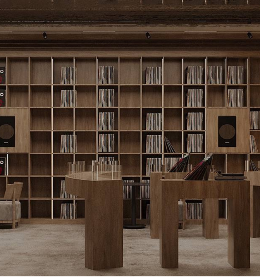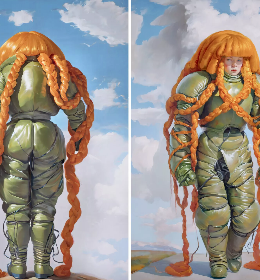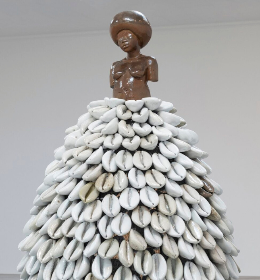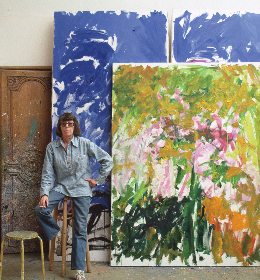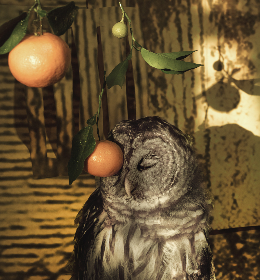Continuing the Safe and Sound series, begun by the artist in 2014, Alona Rodeh’s “DARK AGES 2020” exhibition fits into her “investigation of light as a cultural and physical entity”, continuing her unique research around safety regulations which constantly negotiates tensions between anarchy and order.
Under the direction of Séamus Kealy, Rodeh (represented by the Christine König Gallery) will see her new work exhibited at the Salzburger Kunstverein until March 31. The artist invites visitors into a futuristic, immersive experience in which, “with black walls and black flooring throughout the gallery space, one encounters eight sculptural figures installed in a grid-like pattern.”
Is this a new kind of performance?
Rodeh’s installations are referred to as “performances without performers”, as this seven-minute loop of choreographed light emitted from the sculptures, accompanied by a droning soundscape, is imbued with the theatrics of power, safety, security and control in the public sphere. Although it may not feature any human performers, “I think it’s alive, that’s for sure”, the artist commented.
What does light represent in our society? Is it associated with danger? Parties? Fear?
“I think all of the above, and more”, Rodeh told us. Periods of complete darkness in the exhibition are striking for many, accustomed as we are to urban light pollution. The interplay of light and dark here hints at the potential tyranny of safety, as darkness can mark either chaos, a menacing black-out, or a condition only attainable in highly controlled environments. The artist quotes an essay by David E. Nye on the early days of electricity in theatre to explain the effect: "The power of artificial light to create its own reality only reveals itself in darkness. In the dark, light is life. The spectator sitting in the dark and looking at illuminated image gives it his whole attention — one could almost say, his life."’
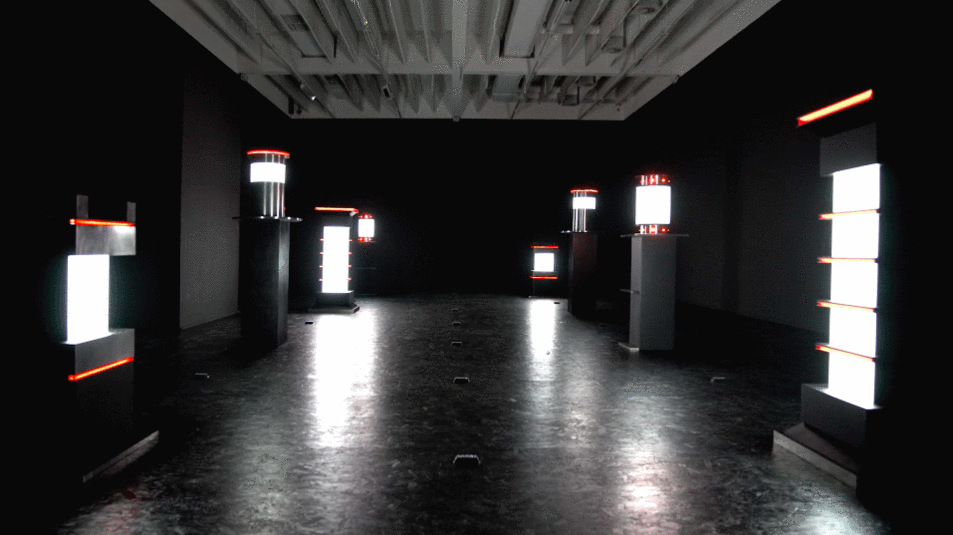
Japanese architect Arata Isozaki wrote “Space = darkness, time = termination; and matter of architecture and cities = ruin and ashes”. What does this mean to you?
“Isozaki wrote about the city as ruins following his experience of the Second World War in Japan. But I found this quote when I was reading about his design of Palladium club in NY, established in 1985. Known for its colourful, light, cubical shapes in space, the Palladium club was the only nightclub he designed. This quote was taken from his discussion of the rise and fall of disco club culture, killed by the AIDS crisis in the 90s. "
Rodeh’s construction of technological and material performances displays surprisingly strong affiliations with clubbing, fashion, theatre and architecture.
“DARK AGES 2020 is not a work about clubs, but it does include the physical presence of light and darkness that one also finds on the dancefloor. It also suggests a near future, in which safety and security instruments take over our cities, a future which has much to do with possible ruins and ashes”, Rodeh explains. The exhibition nods to this possible future through its sculptural figures, which resemble futuristic hybrids of columns, chess pieces, street-lamps, bollard and totems, within which are embedded LED lights and reflective materials. Along with roadwork-esque LEDs placed throughout the grid, the lights illuminate intermittently, blinking together in a choreographed chain, coding signals to one another as sound fills the entire space.
A viewer’s usual surroundings and their own personal experience thus prompts an individual reaction to Rodeh’s work
“What has been surprising, so far, is that this show strongly relates to Salzburgers. First: the sculptures resemble different shapes of bollards, and these were central to recent public debates about the instalment of these in the old city. The community forced the municipality to dismiss the investment, claiming that they are expensive and not necessary. Second has to do with darkness that is very present in the piece. One of the journalists writing about the show sent me to a little scandal from the 70's, when Thomas Bernhard premiered his second play in Salzburg, The Fool and the Madman (1972). The play’s last two minutes were to be performed in total darkness, and he insisted that emergency lights were also switched off. The theatre refused, so Bernhard wrote, furious: ‘an organization that cannot tolerate two minutes of darkness can get along without my play!’ and cancelled the performance.”

How does public reaction figure in your work?
To Rodeh, visitors’ reactions are paramount, and completely contingent on external factors: “this work, or this show, expects singular reactions. It depends if you go inside when its dark or light outside; coming in alone or with a friend, or when someone is there. Coming in a group would make it a totally different experience. Entering when lights are on or when it's totally dark would also make a difference. Your sensitivity to light and your fear of darkness, if you have one, would send you different ideas about the show. It is very concrete and abstract at once, so it depends on its viewer to unfold it — or not.”





